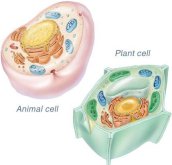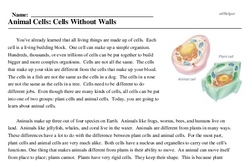Animal Cells: Cells Without Walls
You've already learned that all living things are made up of cells. Each cell is a living building block. One cell can make up a simple organism. Hundreds, thousands, or even trillions of cells can be put together to build bigger and more complex organisms. Cells are not all the same. The cells that make up your skin are different from the cells that make up your blood. The cells in a fish are not the same as the cells in a dog. The cells in a rose are not the same as the cells in a tree. Cells need to be different to do different jobs. Even though there are many kinds of cells, all cells can be put into one of two groups: plant cells and animal cells. Today, you are going to learn about animal cells.
Animals make up three out of four species on Earth. Animals like frogs, worms, bees, and humans live on land. Animals like jellyfish, whales, and coral live in the water. Animals are different from plants in many ways. These differences have a lot to do with the difference between plant cells and animal cells. For the most part, plant cells and animal cells are very much alike. Both cells have a nucleus and organelles to carry out the cell's functions. One thing that makes animals different from plants is their ability to move. An animal can move itself from place to place; plants cannot. Plants have very rigid cells. They keep their shape. This is because plant cells have a thick cell wall that protects and strengthens the outside of the cell. Animal cells do not have a cell wall. They have a thin cell membrane that forms the outside of the cell. Plants have a cell membrane, too, but it is covered by the cell wall. The cell membrane holds all of the parts of the cell together. The cell membrane is thin and flexible. It allows the cell to bend and change shapes. The absence of a cell wall allows animals to move. Skin .....




